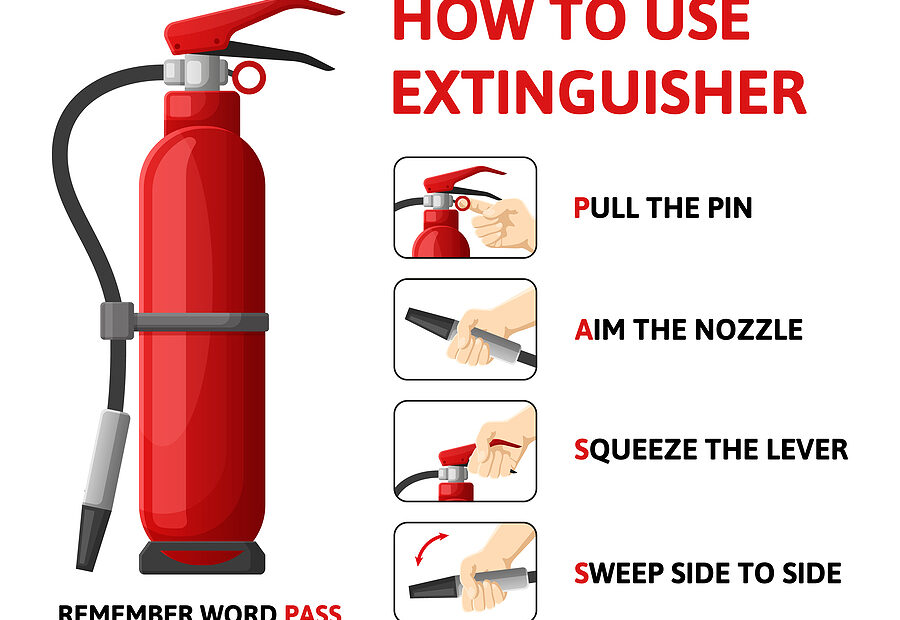As soon as you see fire popping up around your home, your heart starts racing like crazy. But you need to take back control of the situation fast. Learning how to handle a fire extinguisher properly is super critical for every homeowner.
When you know what you’re doing, you might be able to stop a little blaze from turning into a massive inferno. Follow these tips to totally crush it at operating an extinguisher:
Buy the Kind of Extinguisher You Need
Listen up, because not all fire extinguishers are the same. There are a bunch of different types meant for specific kinds of fires. Choosing the wrong one in an emergency can make stuff way worse.
The first thing to do is get yourself an ABC extinguisher. This handy gadget can battle the three most common types of fires:
A – Stuff That Burns Normally: Paper, wood, fabrics, trash – anything standard issue that can catch fire.
B – Oily and Greasy Stuff: Oil, gasoline, paint, grease – slick flammable liquids.
C – Electrical Things: Appliances, computers, wiring – electricity can spark a nasty fire.
An ABC extinguisher gives you the most flexibility for around the home. Make sure to get one with a UL rating and around 5-10 pounds. Any heavier and it’ll be super tough to handle.
Put extinguishers on every floor of your place. Keep them in easy to reach spots like hallways or kitchens. Try not to store them too close to stuff that could catch fire – like your stove.
Take Good Care of It
Buying a fire extinguisher doesn’t mean you’re all set. You’ve gotta maintain that sucker properly so it actually works when you need it. Follow this routine at least once a month:
- Check that the gauge shows full pressure. No pressure = no go.
- Inspect the nozzle and hose for anything blocked up.
- Confirm the safety pin and plastic seal aren’t busted.
- Test it out to make sure it fires properly.
- Shake up dry chemical ones so the stuff doesn’t get caked.
Also get a pro to service your extinguishers annually. They’ll do a full checkup and refill the extinguishing agent. A well-maintained extinguisher is happy extinguisher.
Learn the PASS Method
If you use an extinguisher wrong, you can make the fire get crazy out of control. That’s why you gotta memorize the PASS technique:
P – Pull the pin: This unlocks the lever you need to press.
A – Aim low: Point the nozzle at the base of the fire.
S – Squeeze the lever: Let loose the extinguishing agent.
S – Sweep side to side: Move the nozzle back and forth until it’s out.
Practice PASS a bunch so you’ve got it down during a real fire. Using the right technique is key to put that sucker out fast.
Size Things Up First
Trying to fight a fire yourself has some risks. Before you take action, make sure it’s chill to proceed:
- Judge how big it is and how far it’s spreading. Only small contained fires are cool to combat.
- Scout a clear path to nope out if it rages out of control. Know multiple ways to dip.
- Only use the extinguisher if there’s light smoke around. Heavy smoke means it’s time to evacuate.
- Check that you’ve got the right kind of extinguisher for what’s burning.
If things seem dangerous, grab your fam and get out of the house immediately. Call 911 from outside. Safety first, pyromania later.
Bring Someone Else
Having someone help you with the fire extinguisher makes it way easier to crush that fire fast. You can tag team it from multiple angles. Extra hands help if you need to refill the extinguisher.
Make your family members into extinguisher buddies. Go over the PASS method together. Make sure kids know to call 911 while parents focus on the extinguisher.
Hit the Fire Where It Starts
Lots of newbies make the mistake of aiming at the flames. That won’t really do much. Fires need to be snuffed out at the source so they don’t start again.
Focus on the base of the fire where the burning begins. Sweep back and forth and adjust aim as the flames get smaller. It’ll slowly die out as you extinguish the fuel.
Never turn your back on a fire, even if you think it’s out. Watch out for embers that could ignite it again. Spray any lingering hot spots. Can’t be too careful with fire.
Prevent Round 2 After It’s Out
Just because you don’t see flames anymore doesn’t mean the emergency is over. Check the area for anything that could restart the fire:
- Spread out burnt stuff to uncover hidden embers. Dunk them with water.
- Shut off electricity to damaged appliances until fixed.
- Clean up any leftover flammable spills.
- Close doors and windows to reduce oxygen.
- Take burnt materials outside so they stop smoldering.
Keep your eyes peeled even after using the extinguisher. Don’t peace out until hazards that could restart it are gone.
Replace Empties Right Away
Fire extinguishers are one-and-done. The stuff inside runs out real quick – you get maybe 8-10 seconds of spray time.
Once that extinguisher is all emptied out, replace it ASAP. Keep extras around for fast swap outs. Register new ones with the fire department so they know what’s on hand.
Don’t take chances trying to reuse an empty extinguisher – it probably won’t work if the flames start again. Invest in fresh, full replacements for legit protection.
